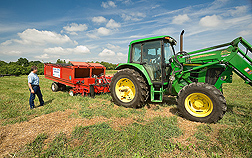This page has been archived and is being provided for reference purposes only. The page is no longer being updated, and therefore, links on the page may be invalid.
| Read the magazine story to find out more. |
|
See our information kit to find out more. |
|
New Poultry Litter Applicator Holds Promise for Chesapeake Bay Area
By Don ComisAugust 2 2010
A machine that can inject dry poultry litter and composted cattle manure below the soil surface in pastures and no-till fields is on order from a research coalition across five Chesapeake Bay states: Delaware, Maryland, Virginia, Pennsylvania and New York. There are currently no machines on the market that can do this.
The coalition is led by U.S. Department of Agriculture (USDA) scientist Peter Kleinman. He works at the Pasture Systems and Watershed Management Research Unit operated by USDA's Agricultural Research Service (ARS) in University Park, Pa. ARS is USDA's principal intramural scientific research agency.
Kleinman and his research partners at Pennsylvania State University at University Park and Virginia Polytechnic Institute and State University at Blacksburg received a $786,000 grant to test four prototypes of the Poultry Litter Subsurfer.
Soil scientist Dan Pote, at the ARS Dale Bumpers Small Farms Research Center in Booneville, Ark., invented the Subsurfer, which injects litter with the minimal soil disturbance required by no-till farmers who do not clear their fields of crop residue before planting a new crop.
In tests on Arkansas pastures, Pote found that the Subsurfer lowers nutrient runoff and ammonia emissions by at least 90 percent, while increasing forage yields. Kleinman and colleagues documented lower phosphorus runoff and ammonia loss and greater corn yields in Maryland and Pennsylvania. Jack Meisinger, an ARS soil scientist in Beltsville, Md., also reported lower ammonia losses.
As a collaborative project, Pote led development of the Subsurfer, while agricultural engineer Tom Way's team at the ARS National Soil Dynamics Laboratory in Auburn, Ala., focused on developing a different prototype with adjustable row spacing for litter application in row-crop systems and pastures.
The two machines have such different delivery systems that Pote and Way sought different patents. Pote's Subsurfer uses a unique auger system that crushes litter and distributes it to soil trenches, allowing precise control, including very low rates not previously feasible. His tractor-drawn Subsurfer carries up to five tons of litter and simultaneously opens eight trenches (two inches wide and three inches deep), with one foot between each trench.
ARS is applying for U.S. and international patents on Pote's Subsurfer. One company has applied for a license to commercialize it. Way's invention has been patented.
Read about this and other research to help protect the Chesapeake Bay in the August 2010 issue of Agricultural Research magazine.

